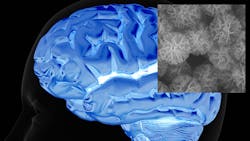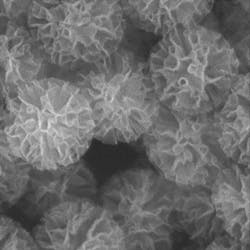Researchers Tailor Nanospheres to Treat Alzheimer’s Disease
One in 10 people over the age of 65 in the U.S. suffer from Alzheimer’s disease. Medical researchers strongly believe it is caused by a gradual buildup in the brain of degenerated nerve cells (β-amyloid (Aβ) peptides), a type of plaque. The condition is believed to cause a loss of neural connectivity and cell death. This is leading many scientists to search for ways to prevent the peptides from forming these dangerous plaques and halt development of Alzheimer’s disease in the brain.
One group made up of scientists at DOE’s Argonne National Laboratory, along with staff from the Korean Institute of Science and Technology and the Korea Advanced Institute of Science and Technology (KAIST), have come up with a novel idea. They are using nano-sized spheres modified to capture the dangerous peptides before they form the plaque and clear them from the brain.
“We’ve taken building blocks from nanotechnology and biology to engineer a high-capacity cage that traps the peptides and clears them from the brain,” says Argonne scientist Elena Rozhkova.
The researchers started with nano-sized spheres of silica, a material that has long been used in biomedical applications due to the ease of making them, the many forms it can take, and its biocompatibility and safety in the body. The spheres are pocked with pores, maximizing the surface area to give biomedical engineers more room to add a layer of antibody fragments. The antibodies recognize and bind to the Aβ peptides.
To find the best coating, the team searched previous literature to identify antibodies with high affinities for Aβ peptides. They needed one that attracts the peptides but doesn’t bind to other molecules in the brain. Then the team manipulated bacteria to produce those antibodies.
The entire antibody molecule can be a few dozen nanometers long, which is large in the realm of nanotechnology. However, only a small part of it is involved in attracting the peptides. To make the coating of the spheres as effective as possible with the greatest capacity for collecting the targeted peptides, the team only attached the “attracting” fragment of the antibodies to the nanospheres.
The scientists tested the effectiveness of the devices by comparing how the peptides behaved when in the presence and absence of the nanodevices. Using transmission electron microscopy and several other advanced imaging techniques, the team saw a notable decline in peptides clumping together when the spheres were present in the presence of the nanodevices.
In tests on mice with Alzheimer’s, the spheres were found to be nontoxic and they reduced plaque formation by about 30%.
Using a similar approach, scientists may be able to add antibodies that target molecules related to other neurodegenerative diseases, such as Huntington’s and Parkinson’s disease, which also involve abnormal protein aggregation. The porous nanoparticles may also be modified for use in fluorescent and magnetic resonance imaging.

